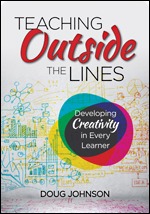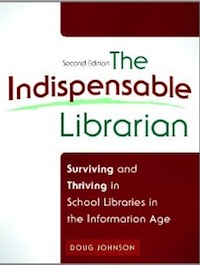Young bloggers - can we stop them? can we steer them?
 Saturday, November 5, 2005 at 08:40AM
Saturday, November 5, 2005 at 08:40AM
Not only do my library friends at LM_Net have interesting discussions, so do my my tech buddies at WWWedu. A major topic this week has been on student blogging and the liability of schools for “bad” student blogging.
(The full text of this discussion can be found on the wwwedu archives or in yahoogroups, from about message 7550 to about message 7597. I have selectively snipped from the messages. I encourage you to read the entire discussion. It's worth your time.)
Friend and highly respected colleague (and national cyber-bullying expert), Nancy Willard (check out her website) offered the following caution:
My concern, focusing on cyberbullying, is that due to lack of effective professional and curriculum development, some teachers may think that letting students go to commercial blogging sites and post material is perfectly okay. …this raises significant liability concerns for schools (please note the JD after my name, something I rarely point out but in this case am).OK, then I went a little ballistic:
I guess I am just feeling cantankerous today, but I am VERY distressed by Nancy's concern about the liability issues concerning blogging.And I threw in my “Proposal for Banning Pencils” for good measure. Hah, that’ll learn’m!
First, (while I have no JD), I do know parents can sue for just dang near anything they want to (and do). This does not prevent us from putting playgrounds, offering football as a sport, or letting kids ride bikes to school.
I also know that districts protect themselves from litigation by practicing due diligence. The question here is not whether we let kids go to commercial blogging sites (or have e-mail or use chat or even have Internet access period), but whether we can document whether we have taught kids the safe use of these resources and make responsible efforts to monitor their use.
Personally, I think this fear of lawsuits stuff has scared too many educators into over-blocking websites and denying kids use of technologies like e-mail, chat and blogging that kids SHOULD be learning to use effectively and appropriately.
Yes, kids are going to make mistakes. That's a part of learning. But isn't it better that kids are making mistakes at school under the supervision and guidance of knowledgeable adults than at home alone or with parents who know little or nothing of the risks? We should be thinking best interests of kids, not least trouble for schools.
There, I feel better.
And did Nancy get mad? Nooooo. She wrote the wonderful reasoned response:
A couple of points: I do not think there is "potential misuse," I think there is a high probability that students are using Internet systems in schools to cyberbully each other. And some students who are being cyberbullied are committing suicide, as well as this is leading to school failure, school avoidance, and the like.
Further, based on what I know about the facts of the case -- which is admittedly limited -- I think there is a good possibility that the Red Lake shooter and other students were discussing the shooting in advance and, given they were teens it is probable these discussions were electronic, and given this was a reservation I suspect some of these discussions were through the district Internet system.
And I will tell you that this raises liability concerns for districts.
So here is a quick primer on negligence law.
There are four elements:
Schools have a duty to anticipate foreseeable dangers and to take necessary precautions against those dangers to protect students in their care. A breach of the duty occurs when a school official fails to exercise a reasonable standard of care. The issue of proximate cause asks whether the student’s injury something that could have been foreseen and prevented by a school official. Damages sustained as the result of bullying may include emotional harm and the costs of addressing that harm (e.g. the costs of counseling), losses to student due to the student’s avoidance of school (eg. lowered school performance, which will interfere with student’s future educational opportunities), and the like.
- A legal duty.
- A breach of that legal duty.
- Proximate cause—the breach of the duty was a substantial factor in bringing about an injury, damage, loss, or harm.
- Actual injuries, loss, or damage.
Clearly, schools have a duty to protect students when using the Internet. It is foreseeable that students could be using the district Internet system to bully each other or could post material online that provides indications of a threat.
So the key question is: "What is the reasonable standard of care?" And then for a school, it will be a question of fact regarding whether a particular school was exercising a reasonable standard of care. Schools can't guard against ALL harm, but if a harm is foreseeable, then they must take reasonable steps to guard against it.And Nancy adds:
Banning computer use is clearly not the answer. Banning all blogging is also not the answer. But if we cannot establish practices that meet a "reasonable standard of care" then some administrators may think banning is the answer. So the last thing I want to do is tell administrators that they have a problem without telling them what they can do to address the problem and still encourage the effective use of technology for good educational purposes.
….
So, I am telling you that there is a high probability that students are misusing the Internet in schools to bully each other and this could cause significant harm to youth. You tell me what reasonable precautions need to be made in all schools to guard against this kind of harm.
OK, I’ll admit that I slept through my school law class and Nancy paid attention all the way through real law school.
What is really cool is that Nancy solicited ideas from the other members of WWWEDU (who she tells me personally she can always count on for good ideas) about what would constitute “reasonable standard of care.” From these messages she generated the following major points:
- Having a focus on professional and curriculum development related to these technology issues.
- Using technology for student blogging that gives the teacher a maximum amount of control and that blogs are focused on class work activity.
- Having teachers engage their students in blogging – but teach them about responsible blogging.
- Having guidelines for student behavior that promote student learning.
- Promoting collaboration between safe school folks (who tend not to know much about technology but a lot about behavior) and ed tech folks (who understand the technology, but may not know a lot about the issues related to safe schools).
- Making sure that staff and students know about the policies.
- Having guidelines for teacher behavior.
- Considering policies regarding actions to taken when a student is the victim of a harmful communication
- Educating students about
- the folly and potential downsides of making online threats.
- the importance of reporting such threats (even if they may not be real)
- Having a confidential/anonymous reporting system that specifically refers to and provides the ability to report concerning online material -- including an online reporting mechanism.
- Having a systematic situation review process to figure out who is the bully and who is the target in the overall situation and determine the legitimacy of any online threats.
And finally from Nancy:
However, the thread ended too soon and there is at least one other item that should be on this list — and that is doing a regular needs assessment. Don’t just accept my word that this is a problem. I’m telling you that I think there is a high probability of the problem here, but it is really important for schools and school districts to figure out to whether there is a problem, to what extent there is a problem, how the problem emerges, etc. Then, based on this information, more specific appropriate strategies can be developed. The other items on the list are important basic approaches that I think should be implemented in all schools — and not only will help address the concern of cyberbullying, but also enhance the more effective use of Internet technologies for high quality educational purposes. But if a school finds that there are particular problems with student misuse of computers in the library during lunch time, then specific measures can be taken to address this concern.
Cindy Penchina, David Warlick, Art Wollinsky, John Thompson and others also contributed great insights into this issue. Go back and read the archives.
Fellow educators, let’s not delude ourselves. Student blogging happens whether we like it or not. (See the new Pew study on teen-age blogging.)
We can’t stop student bloggers – period. But can we steer them by giving them guided practice in our schools? Personally, I believe the responsible answer must be “yes.”
Two side thoughts…
- Is it ethical to repeat the conversations from a listserv in a blog without the express permission of the writer to the listserv? Is taking conversations out of context (for brevity sake) fair to the original writer? (Like it doesn’t happen in journalism!)
- Are listservs a better choice of technology than blogs to conduct this sort of “discussion?” My current experience both with this blog and the others I read is that they are more a public forum for the opinions of the blogger than a discussion forum, despite that not being the intent of the blogger him/herself.
Your thoughts on student blogging in schools?









